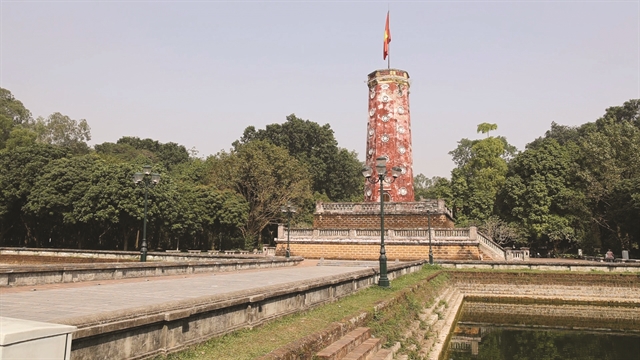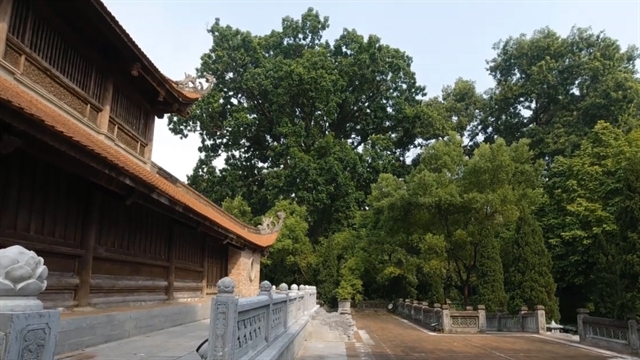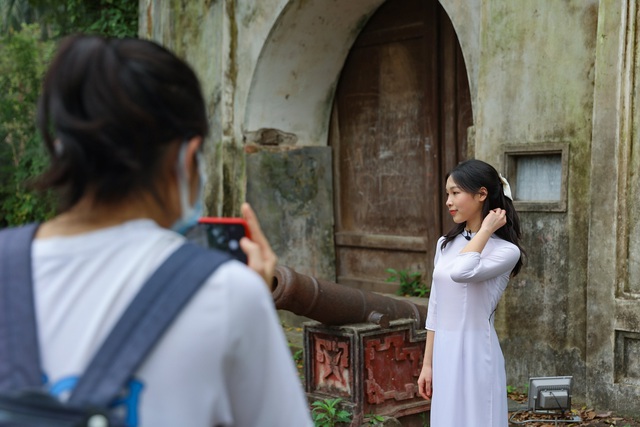Weather:
- Ha Noi 35oC
- Da Nang 31oC
- Ho Chi Minh 34oC

By Lương Hương – Minh Phương
Surrounded by the bustling streets of Sơn Tây Township, 40 km from the centre of Hà Nội, the Sơn Tây ancient fortress is a tranquil oasis shaded by luxuriant rows of ancient trees.
The landmark, covering a total area of 16 ha, not only bears historic value but also attracts increasing attention for its unique architecture. Tourists are able to see the remains of the once famous military rampart while enjoying the peace and quiet.
According to the book Thành Cổ Sơn Tây (Sơn Tây Ancient Citadel) of Sơn Tây People's Committee, Sơn Tây used to be one of the four major townships defending Thăng Long (Hà Nội), located in the west of the capital.
Also known as Đoài Land and as a sacred land with extraordinary people, Sơn Tây has a rich history and culture. The locality, part of the lands protecting the ancient citadel as well as present-day Hà Nội, has always been important strategically and militarily.
The site contains many vestiges reflecting the Vietnamese people's indomitable struggle, loyalty and resilience in the fights against foreign invaders.

The citadel was built in 1822 during the reign of Emperor Minh Mạng (1791-1841) under the Nguyễn Dynasty. Though it was among 20 citadels built in Nguyễn Dynasty, it was the only one built entirely of laterite, a good material for defensive building that is available locally.
The 200-year-old citadel used to have four gates in four directions – Tiền (Front) Gate, Hậu (Back) Gate, Hữu (Right) Gate and Tả (Left) Gate. Each gate had a gazebo and gun-section. Only the Tiền and Hậu Gates remain today, with the first overlooking Quang Trung Street and the second facing Lê Lợi Street.
The relic is surrounded by a 400m-long and 5m-high wall, together with a 3m-deep, 20m-wide and 1,800m-long moat.

In the citadel, major works are built symmetrically along the south – north axis. At the entrance is Ngọc Well and the 30m-high watchtower, which is now hanging the national flag.
Situated in the heart of the site is Vọng Cung, a guest house for the emperors to rest after patrolling and where the local mandarins once conducted rituals and received royal decrees every spring. Now the building has become a temple worshipping deities and national heroes.
During the 1870s-80s, the citadel was the centre of the resistance wars against the French, led by mandarins of the Nguyễn court such as Hoàng Kế Viêm or Lưu Vĩnh Phúc. Due to its strategic location, the French colonists had to conduct three attacks from Hà Nội and finally took control of the citadel in 1884.
Although Vietnamese people did not win the fight to protect the western citadel, it marked a great development in the country's military in terms of strategy and tactics, and also aroused fear among the French colonialists.

In 1924, the Governor-General of Indochina issued a decree to rank the ancient citadel as a relic, and in 1994, the landmark was recognised by the Ministry of Culture and Information as a National Historic Landmark.
Sơn Tây Citadel was also the venue for many major events, such as the meeting of the provisional government council of the Democratic Republic of Việt Nam that aimed to decide the first important issues of the nine-year-long resistance war.
According to Chairman of the Vietnam Archaeological Association Tống Trung Tín the Sơn Tây Citadel represents a period of the most rampant construction in Việt Nam, in the context of colonial conquests worldwide.
Through many ups and downs, while many other citadels have been demolished or covered with modern buildings, Sơn Tây Citadel has retained its vestiges, demonstrating the construction techniques and defensive military works in Việt Nam’s north.
Tourist destination
According to experts, Sơn Tây is among the few citadels having their space remain intact today. No residential, public buildings, or military works have been constructed in or encroached on its space.
With its long-standing and unique historical and cultural values, the citadel has become a destination for students to visit and learn about patriotic traditions and heritage preservation.

As the only laterite citadel in Việt Nam today, it impresses visitors with its serenity and calm.
“As a cultural and historical relic as well as an ecological park, the citadel has received significant investment from the State and support from local people for its conservation,” said Nguyễn Trọng An, the deputy head of management of Sơn Tây Ancient Citadel Relic.
Since the 1990s, many projects to embellish items within the citadel have been carried out, such as the innovation of the watchtower, the Vọng Cung building and several paths within the park.
Notably, two Mic21 aircraft from the Sao Đỏ (Red Star) Regiment and one Mic8 aircraft from Regiment 916 are displayed at the entrance of the relic site as a memory of war.
2022 marked the citadel’s 200 years of existence, and a series of cultural, tourism, and sporting events were organised to raise public awareness about heritage protection and preservation. They included an exhibition of photos, artefacts, ornamental trees and paintings, together with an international hot air balloon festival.
A new pedestrian zone around the citadel was opened for Reunification Day (April 30). The 820-metre-long pedestrian zone, spanning several streets around the ancient citadel, is expected to help expand trade, services and tourism, contributing to preserving the cultural heritage of the locality.
Many special art and cultural programmes have been held in the pedestrian zone, attracting tens of thousands of visitors.
“The celebration of the 200th anniversary of the establishment of the ancient fortress has received great support from residents both inside and outside Sơn Tây Township, showing the concern of both the Party and the State, and honouring the values and potential of the heritage here,” An said.
The citadel also attracted many tourists this Tết (Lunar New Year) holiday to watch the fireworks on New Year's Eve and attend the exhibition of special editions of newspapers for Tết, or contemplate artworks crafted by local artisans.
Travelling more than 10 km to visit the relic in the early days of the Lunar New Year, 31-year-old Nguyễn Thị Nga expressed her surprise at the sheer beauty of the ancient citadel.
"My family has been most impressed with the fresh and tranquil atmosphere here. It is rare to find such vast space shaded by ancient trees in Hà Nội nowadays. My two children were so excited to take pictures with the military planes on display and learn about our national history. I will take them there again for sure," she said.
At present, the local authorities are compiling a dossier requesting recognition of a special national relic for Sơn Tây Citadel.
"This will act as an important foundation for Sơn Tây Town and locals to promote the values of the relic, effectively implement the Law on Cultural Heritage and make the locality worthy of being one of the five satellite cities of Hà Nội," An noted. VNS


